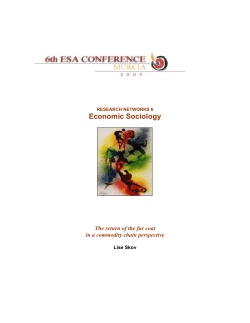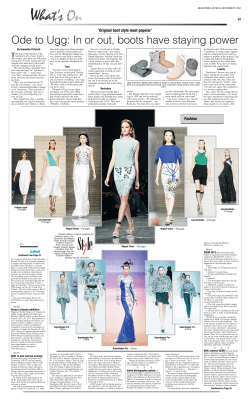
Modern Classic
advertisement advertisement Conference (November 2007). “For us, fur is our diamonds.” Russian consumers, as well as those in many Middle Eastern countries, have an expansive concept of luxury and lifestyle, experts conformed. “Those consumers live big and play big,” said Designer Rubin Singer. “Fur fits perfectly into that mentality.” Sales of sable, chinchilla and mink have been particularly robust overseas, noted Nathan. He predicts an increase of 20- to 30-percent on the price of mink in the next year alone. rubin singer Rare Finds Modern Classic While classic furs continue to have timeless appeal, designers are looking at fur in new and modern ways. “No longer just a classic coat expected to stand the test of time, fur is fashion!” said Downing of Neiman Marcus. Ease of wear is also important to modern-day consumers. Adding unique fur pieces to his latest collection, Russian Designer, Denis Simachev produced light, almost weightless products. “To achieve such an effect we take separate slices of fur and knit them together — this way a fur piece looks like knitwear and is warm and light at the same time,” he said. Using this manufacturing method, Simachev turned out plush fur scarves and pullovers for the Fall/Winter 2008-2009. Lightweight styles are prominent across the board, as are silks with fur trims and belted fur jackets. But regardless of style, the material still appears to speak for itself. “I use fur because there is no comparison to the look, the feel and the warmth of real fur” said Singer, who debuted his first-ever collection at NY Fashion Week in February 2007. “My usage of fur was intended to elevate and articulate the linear composition and volume of the collection. I use paneling and seaming to create surface interest and silhouette. By paneling and splicing the different furs I was using, I was developing depth, line value and form.” Designers’ use of fur extends beyond luxurious coats and jackets to a variety of accessories that have become increasingly important. With a broader range of products appealing to a wider audience, fur items are being paired with everything from jeans to evening gowns. “Sales of smaller pieces have seen a huge increase,” said Kaplan. “This has shown us that fur is becoming more and more a part of the fashion vernacular.” In the view of Sheikh Majed Al-Sabah, individuality is valuable to the high-end consumer, making customization key. “Because of its rarity, we tend to sell a lot of fur pieces,” said Sheikh Majed, president of Kuwait-based Villa Moda Lifestyle, a luxury retail concept he launched in the Middle East in 1991. “Women here are very much looking for something iconic, of the moment, and sexy — something custom-made just for her.” Most of the fur business at Villa Moda — a multi-brand luxury fashion store housing individual upscale boutiques for brands like Gucci, Prada, Fendi and Salvatore Ferragamo — Today, a large part of being fashionable is being Sheik Majed Al-Sabah comes from the sale of items like stoles, shawls and handbags, responsible. At the International Herald Tribune’s Supreme said Sheikh Majed Al-Sabah. Luxury 2007 conference in Moscow late last year, Villa Moda exists in Syria, Qatar and Kuwait. Sheikh Majed Designer Tom Ford reinforced the significance of ethics Al-Sabah plans to derive the majority of his fur sales, however, and their importance to the luxury market, noting that a from Dubai, where he launched his most recent concept store and is currently key aspect of “new luxury” is “the ability to enjoy things that haven’t had a developing a center combining retail, art and fine dining in conjunction with the destructive impact on the planet or on other people.” Ford speculated that Dubai International Financial Centre (DIFC). products that indicate that their owner is both chic and has a conscience Rubin Singer also stressed the importance of themes like “rarity, provenance will become the ultimate status symbol. and purity” in his work. “To solidify the vision, precision and look of my clothing, IFTF’s Juliette Bailey agreed, adding that the Federation’s research it is imperative that I use materials and workmanship that both my customer indicates that whether you are talking about food, coffee or fashion, an and I expect,” he said. “My clothes are intended for strong, bold, refined women increasing number of people want to know that their purchase comes from who expect quality and uniqueness. a source where ethical standards are in place. To that end, IFTF introduced its Origin Assured label, which assures that the fur or fur product a consumer purchases comes from a country where villa national or local regulations or standards governing fur production are in moda force. IFTF joined with an experienced international monitoring agency to establish an independent verification program and enforce that the mark is used correctly. “We believe that the Origin Assured mark is an important link to our consumers,” said Bailey. “They love fur and we want them to know that they are making a responsible choice by choosing fur carrying the Origin Assured mark.” Designers like Simachev appreciate the efforts IFTF has made. “It is extremely important to both me and my consumers to have an understanding of where the materials we carry come from,” he said. “We always pay close attention to the selection of suppliers and prefer to cooperate only with respected and experienced factories and suppliers.” As long as ethical and quality standards are enforced, “real fur will always be better than any of the substitutes,” expressed Simachev. “Because of its rarity, we tend to sell a lot of fur pieces. [Middle Eastern] women are looking for something iconic,of the moment, and sexy.” J. Mendel for neiman marcus Rick owens Staying Strong Fur continues to play a starring role in the collections of leading global designers, who showcased their newest fur designs and accessories during the Fall Collections Seasons in Paris, London, New York and Milan. The runways featured coats, vests, stoles, scarves, hats and more, ranging from casual to formal, classic to contemporary. And, as always, luxury was in the forefront. “Luxury is not a price-tag, but an experience,” said Ken Downing, senior vice president and fashion director at Neiman Marcus, where fur remains an important part of the fashion mix. “Our customer is in constant search of the finest, the unique and the glamorous. Fur fulfills the desire for all of that and more.” The opulent material certainly has its loyal followers in the couture world. “I’m a big fur person,” said Fashion Designer Rick Owens. “I use it every chance I get.” Owens’ newest collection, unveiled at Paris Fashion Week 2008, features mink coats that tie at the chest or neck and drape down the torso. Oscar de la Renta, Bill Blass, Carmen Marc Valvo and Michael Kors were just a few others to show their softer side on the February runways, revealing fur’s continued relevance in the fashion world. For proof that this fabric is in demand, look to recent growth figures from the International Fur Trade Federation (IFTF). According to IFTF statistics, fur sales increased 40 percent during the nearly decade-long period ending in 2006. Furthermore, the threat of a luxury slowdown did not affect global fur sales in 2007. The Federation’s latest survey reveals that customers spent more than $15 billion on fur and fur accessories last year, an annual increase of just over 11.34 percent. American consumers continue to buy fur despite the slow economy, confirmed Peter Nathan, president of New York City-based buying house Peter Nathan, Inc., a company that services 30 retail stores across the U.S. Sheared fur, in general, has been a strong performer, he said, noting particular strength in lightweight shears that are reversible and shorter in length (up to 38”). Also popular, he added, are silhouettes that are dyed or laser-cut, a process that creates three-dimensional patterns for decorative applications. According to Keith Kaplan, executive director of the Fur Information Council of America [FICA], there are a few specific reasons that fur continues to perform at retail — and why he doesn’t expect to see any declines in 2008. Fur has been able to ride out the economic slowdown “due to strength in the [ultra] luxury items, strong sales in smaller fur items and accessories, and the cold winters we have been having,” he stated. Meanwhile, typically cold climates in rapidly developing economies, like Russia and China keep fur prices on the rise. The Russian market, in particular, is looking strong thanks to companies like Fendi. “We have been among the pioneers here in Russia because Russian women have always loved the Fendi furs and here we sell the most avant garde furs,” commented Designer Silvia Venturini Fendi of Fendi in an interview with the International Herald Tribune at the IHT Luxury Responsible Fashion For more informatioN: International Fur Trade Federation denis simachev www.iftf.com www.fur-style.com www.originassured.com
© Copyright 2025
















